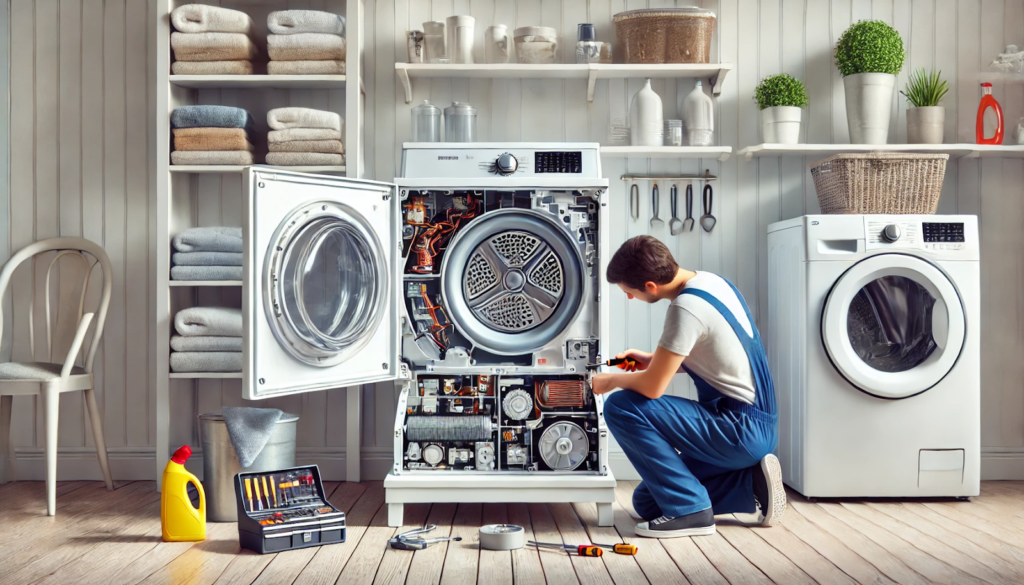The clothes dryer is one of the most crucial yet overlooked appliances in the home. It saves time, simplifies laundry tasks, and ensures your clothes are ready to wear when you need them. But like all machines, dryers are prone to wear and tear. Regular use can lead to various malfunctions, from minor inconveniences to complete breakdowns. Understanding common dryer issues, when to seek professional help, and how to perform basic maintenance can save you money and extend the lifespan of your appliance.
In this article, we’ll explore the ins and outs of dryer repair, providing homeowners with the knowledge they need to keep their machines in tip-top shape.
Common Dryer Problems
Over time, a dryer may start displaying signs that something is wrong. Identifying these early symptoms can help prevent a minor issue from turning into a costly repair. Here are the most common dryer problems:
1. Dryer Not Heating
One of the most frequent complaints is when the dryer drum rotates, but the clothes remain damp after a full cycle. This issue is typically caused by a malfunctioning heating element, blown thermal fuse, or faulty thermostat. In gas dryers, a broken igniter or gas valve may also be to blame.
2. Excessive Noise
If your dryer starts making unusual noises such as grinding, squeaking, or thumping, there could be an issue with the drum support rollers, belt, or bearings. A malfunction in these parts can create friction, leading to noise and potential damage to other components.
3. Overheating or Shutting Down Mid-Cycle
Overheating dryers are not just inconvenient—they’re dangerous. If your dryer gets too hot or shuts down in the middle of a cycle, clogged vents, defective thermostats, or worn-out motors might be the culprit. Regularly cleaning your lint trap and checking venting systems is crucial for preventing overheating.
4. Dryer Not Starting
A dryer that refuses to start may be suffering from electrical issues, such as a broken door switch or blown fuse. Another possibility is that the drive belt has snapped or the motor has burned out, rendering the machine unresponsive.
5. Clothes Taking Too Long to Dry
If your clothes are taking more time to dry than usual, airflow restrictions are likely the problem. Blocked dryer vents, dirty lint filters, or an inefficient blower wheel can slow down the drying process and make your machine work harder than it should.
DIY Troubleshooting Tips
Before calling a technician, there are a few troubleshooting steps you can take to diagnose or even fix minor dryer problems. Here are some easy solutions to try at home:
1. Check the Power Supply
Ensure that the dryer is properly plugged in, and check the breaker to see if it has tripped. A simple reset might be all you need to restore power to your appliance.
2. Clean the Lint Trap and Vents
A buildup of lint can block airflow, making the dryer less efficient and even dangerous. Regularly clean the lint trap after every load and periodically inspect the vent hoses for any clogs.
3. Inspect the Drum Belt
A broken drum belt can cause the dryer to stop spinning. If you suspect this is the case, open the dryer to inspect the belt for cracks or snaps. If it’s damaged, a replacement is necessary.
4. Listen for Noises
The type of noise your dryer makes can tell you a lot about what’s wrong. Squeaking noises may point to a worn drum bearing, while a thumping sound could mean an issue with the rollers or motor mounts.
When to Call a Professional
While some repairs are manageable at home, others require a professional’s expertise. Knowing when to call a technician can save you time and prevent further damage to your appliance.
1. Electrical Issues
Working with electrical components can be dangerous without the proper knowledge. If your dryer has electrical problems, such as a malfunctioning control panel or wiring issues, it’s best to seek professional help.
2. Gas Dryers
Gas dryers involve complex systems that require specialized tools and knowledge. If you have a gas-powered unit that isn’t heating or has issues with its ignition system, don’t attempt to fix it yourself. Contact a certified technician.
3. Complex Mechanical Failures
If you’ve inspected your dryer and can’t pinpoint the problem, or if the repair involves disassembling large sections of the machine, it’s time to call in a professional. Attempting a DIY fix without the right experience can lead to further damage.
Expert Insights on Dryer Maintenance
To gain expert insight into dryer repair and maintenance, we consulted specialists at Superior Appliance Service https://superiorapplianceservice.ca/, who have years of experience in repairing home appliances. They emphasize the importance of regular maintenance, stating, “One of the best ways to extend the life of your dryer is to clean the venting system annually. Clogged vents not only decrease performance but can also be a fire hazard.”
Superior Appliance Service also recommends investing in a professional dryer inspection every few years to ensure all components are functioning correctly. Catching minor issues early can prevent costly repairs down the line and keep your dryer running efficiently for many years.
The Importance of Dryer Vent Cleaning
One of the most critical yet often overlooked aspects of dryer maintenance is vent cleaning. Dryer vents are responsible for expelling the hot, moist air from your appliance. When these vents become clogged with lint or debris, it can significantly impact your dryer’s performance and pose a serious fire hazard.
According to the National Fire Protection Association (NFPA), dryers are responsible for thousands of home fires every year, with failure to clean the dryer being the leading cause. This makes routine vent cleaning a vital part of dryer maintenance. You can clean the vent by using a vacuum or vent brush to remove lint buildup. If your vent is difficult to access, consider hiring a professional service to handle the task.
Preventative Maintenance: The Key to Avoiding Costly Repairs
Preventative maintenance is the most effective way to avoid unexpected breakdowns and expensive repairs. Here are some tips to keep your dryer in good working order:
- Clean the lint trap after every load to ensure optimal airflow.
- Check the exhaust vent at least twice a year to prevent lint buildup.
- Inspect the door seal for signs of wear and replace it if necessary.
- Avoid overloading your dryer, as this can strain the motor and drum.
Following these simple steps can help you avoid unnecessary repairs and prolong the lifespan of your appliance.
Dryer repair doesn’t have to be a daunting task. By understanding the most common dryer issues, performing basic maintenance, and knowing when to call a professional, you can keep your machine running smoothly for years. Remember, regular upkeep and cleaning are key to preventing bigger problems down the road. If you do encounter a more complex issue, don’t hesitate to contact experienced professionals like the team at Superior Appliance Service to ensure your dryer is in safe hands.
With the right care and attention, your dryer will continue to serve you well, making laundry day just a little bit easier.







